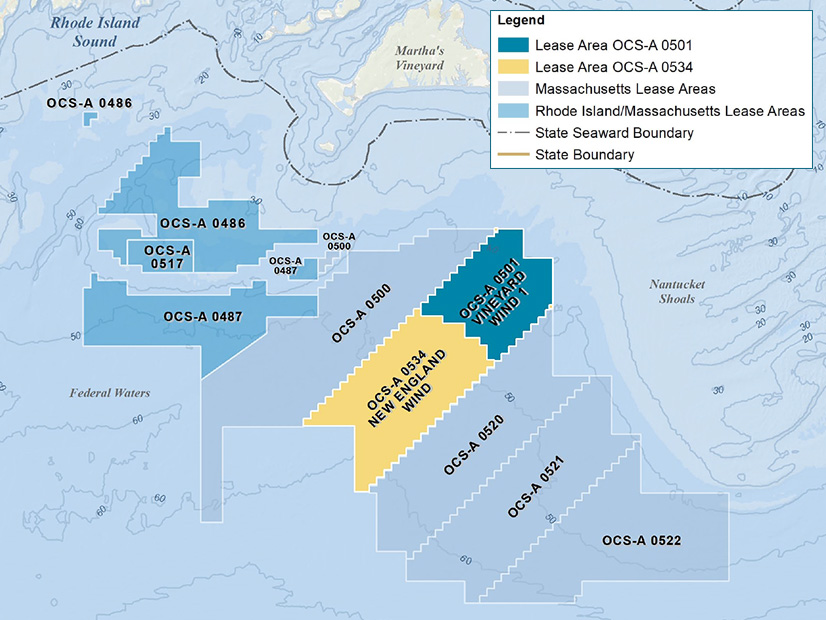
Two proposed wind farms off the New England coast are nearing approval by federal regulators.
The U.S. Bureau of Ocean Energy Management on Feb. 26 announced it had finalized the environmental impact analysis of New England Wind.
Publication of a project’s final environmental impact statement (EIS) typically is followed several weeks later by a record of decision. All six of the decisions BOEM has issued so far have been approvals.
In this case, the EIS is for two wind farms proposed by Avangrid within the 101,590-acre Lease OCS-A 0534: Park City Wind and Commonwealth Wind, neither of which currently has an offtake contract for their combined potential output of more than 2 GW.
Avangrid terminated its power purchase agreements for both projects in 2023 when their terms became financially untenable amid rising construction costs. (See Avangrid Avoids Major Offshore Wind Losses.)
Avangrid has said it still plans to develop the projects, but under profitable terms. There is a chance to pursue this now: Connecticut, Massachusetts and Rhode Island remain eager to decarbonize their grids and are holding a combined offshore wind solicitation for up to 6 GW of capacity, with bids due March 27. (See New England States Delay Offshore Wind Solicitations.)
BOEM published a draft EIS in December 2022 and received 776 public comments in response. It considered multiple scenarios within the final EIS before choosing as the preferred alternative a version of the original plan modified to minimize impacts on complex fisheries habitats.
There is minimal operational data in U.S. waters from which the environmental impact of a given offshore wind proposal can be estimated. The first two utility-scale projects still are under construction.
As with the assessments BOEM has carried out for other proposed wind farms in the New York-New England region, the New England Wind EIS presents a range of possible outcomes good and bad for each assessment category.
Most effects are assessed as minor to moderate beneficial or harmful.
However, the critically endangered North Atlantic right whale; commercial and for-hire recreational fishing; cultural resources; scientific research and surveys; the view from land; and national security and military uses could see “major” negative impacts from New England Wind under BOEM’s preferred scenario, particularly in combination with other underwater energy activities in the region.
One of the EIS appendices indicates an increased potential threat to whales and other marine mammals from vessel strikes and fishing gear entanglement. (See Feds Issue Strategy to Protect Right Whale Amid OSW Push.) This and some of the other effects are potentially “irretrievable.”
But BOEM concludes the majority of marine and onshore environments would return to normal long-term productivity upon decommissioning.
The predicted impacts of the status quo — continued greenhouse gas emissions from fossil power generation, and the resulting climate effects — are judged to be almost as significant in their own way as the potential impacts from construction and operation of New England Wind, an emissions-free power source.
The record of decision is the next milestone for New England and one of the biggest, along with securing contracts for its electricity. Additional reviews and approvals must be secured before construction can start, but a positive record of decision essentially is a green light for a project.
BOEM said in its announcement of the EIS that the record of decision would come in April or later.
Phase 1 of New England Wind is Park City Wind, with one or two offshore substations and up to 62 turbines with combined capacity of at least 804 MW coming online as soon as 2028.
Phase 2 would be Commonwealth Wind, with one to three offshore substations and up to 88 turbines rated at 1,232 to 1,725 MW; full buildout would be dependent on market conditions and offshore wind turbine technology advancement.
In an adjacent lease area, Avangrid and Copenhagen Infrastructure Partners are building Vineyard Wind 1 in a 50-50 joint venture.



